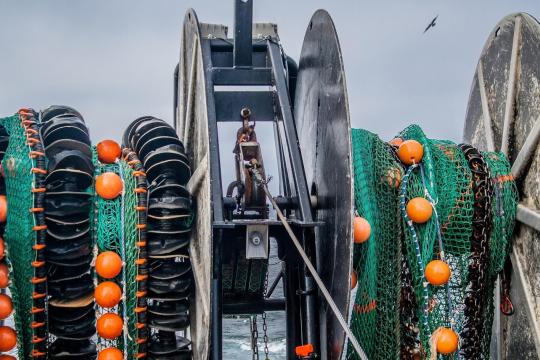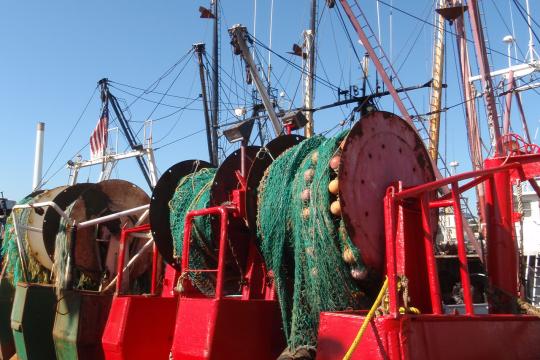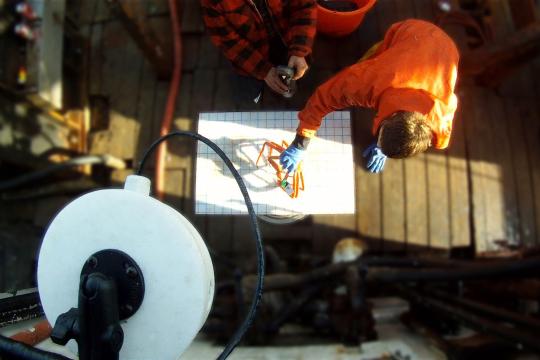New England/Mid-Atlantic (original) (raw)
New England and the Mid-Atlantic, including the Chesapeake Bay, have a long and storied history of fishing.
Fishing continues to define our culture today, with lobsters, sea scallops, crabs, and a variety of fish filling our menus and attracting tourists from all over the world. New Bedford, Massachusetts, is consistently among the highest value ports in the United States, thanks to the lucrative scallop fishery. Recreational fishing is a popular pastime, contributing billions to our economy. Many fishermen still fish in the same places and for the same species as their ancestors hundreds of years ago.
We are also dedicated to conserving, protecting, and rebuilding endangered and threatened marine and anadromous species in rivers, bays, estuaries, and marine waters off New England and the Mid-Atlantic. Our work helps ensure the survival of protected marine mammals, sea turtles, and fish for future generations.
Our work to maintain sustainable fisheries and protect marine life is a joint effort of the Greater Atlantic Regional Fisheries Office and Northeast Fisheries Science Center, offering sound science to help inform management decisions in an ever-changing environment. To find out more about our work, read our 2020-2023 New England and Mid-Atlantic Regional Strategic Plan.
Featured News

 New England commercial fishing trawl vessel. Credit: NOAA Fisheries
New England commercial fishing trawl vessel. Credit: NOAA Fisheries
 Excavators on the Chequessett Neck Dike over the Herring River. (Credit: Molly Feltner/NOAA)
Excavators on the Chequessett Neck Dike over the Herring River. (Credit: Molly Feltner/NOAA)
 Seafood on ice for display. Credit: Shutterstock
Seafood on ice for display. Credit: Shutterstock
 Authorized responders from the Seacoast Science Center take measurements of a dead humpback whale that stranded in Marblehead, Massachusetts. Credit: Seacoast Science Center.
Authorized responders from the Seacoast Science Center take measurements of a dead humpback whale that stranded in Marblehead, Massachusetts. Credit: Seacoast Science Center.
Featured Highlights
 The twin trawl was rigged with two nets with different sweeps; rockhopper on the left and chain on the right. Photo: NOAA Fisheries
The twin trawl was rigged with two nets with different sweeps; rockhopper on the left and chain on the right. Photo: NOAA Fisheries


Science Overview
In 1871, NOAA Fisheries’ first laboratory was founded in Woods Hole, Massachusetts. Since then, our research has promoted recovery and long-term sustainability of marine life in the region and sustaining coastal communities. Through our comprehensive marine science program, we study fishery species and fisheries, monitor and model ocean conditions and habitats, develop aquaculture, and provide reliable advice for policymakers. We're also home to the Woods Hole Science Aquarium, the nation's oldest public marine aquarium.
Fisheries Overview
We work cooperatively with the New England and Mid-Atlantic Fishery Management Councils, and the Atlantic States Marine Fisheries Commission to develop, review, and implement fishery management plans in federal waters (from 3 to 200 nautical miles). Our research and research surveys provide the necessary information needed to evaluate the overall health of more than 50 fisheries with 14 fishery management plans in our region, from Maine to North Carolina, an area about the size of California.
Protected Marine Life Overview
We are dedicated to research and management to conserve, protect, and rebuild endangered and threatened marine and anadromous species in rivers, bays, estuaries, and marine waters of the Northeast and Mid-Atlantic. Our work helps ensure the survival of protected marine species for future generations.
Habitat Overview
Healthy habitats are the foundation of healthy fisheries. We work to protect, conserve, and restore habitats for fishery resources under our stewardship. We also conduct research on marine life to determine how habitat loss, degradation, restoration, and mitigation affect ecosystems. Our vision is for healthy and self-sustaining coastal and marine habitats that support vital ecosystem functions, including abundant living marine resources, human uses, and resilient coastal communities. We work cooperatively with a wide variety of federal, state, and local agencies and non-governmental organizations to protect and restore habitat to sustain fisheries, recover protected species, and maintain resilient coastal ecosystems and communities.
Species Overview
Species that we manage, protect, and study in the New England/Mid-Atlantic Region.
We manage 42 commercial and recreational fish and shellfish for sustainable use. We protect and conserve dozens of marine mammal, sea turtle, and endangered fish species from Maine to North Carolina.

Well over 100 species, including finfish, shellfish, urchins, and seaweeds, are landed in the Northeast. Credit NOAA Fisheries